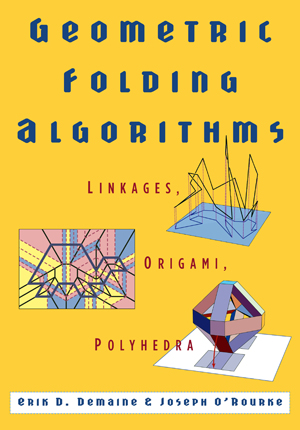
textbook

poster
(see Origami Maze Folder
and associated paper)

old poster
(see Origamizer
and bunny video)


poster
(see Origami Maze Folder
and associated paper)

old poster
(see Origamizer
and bunny video)
the algorithms behind building TRANSFORMERS and designing ORIGAMI
Whenever you have a physical object to be reconfigured, geometric folding often comes into play. This class is about algorithms for analyzing and designing such folds. Motivating applications includeThis year we will be experimenting with online lectures. Students will be expected to watch recorded lectures, allowing in-class time to be more interactive through folding experiments, answering questions, collaborative projects, clarifying proofs, and exploring new results and applications.
We will organize an optional problem-solving session, during which we can jointly try to solve open problems in folding. In the past, these sessions have led to important new results and published papers, as well as class projects.
Class projects more generally can take the form of folding-inspired sculptures; formulations of clean, new open problems; implementations of existing algorithms; or well-written descriptions of one or more papers in the area. Projects can be purely mathematical (geometric) and/or theoretical computer science (algorithmic/complexity theoretic) and/or artistic. Students are also required to do a project presentation and a small number of problem sets.
Additional recommended reading is Origami Design Secrets: Mathematical Methods for an Ancient Art by Robert Lang.
| Lecture Time: | Tuesdays and Thursdays at 10:00am–11:00am |
|---|---|
| Lecture Room: | MIT room 3-370 |
| First Lecture: | Thursday, September 6, 2012 |
| Problem Session Time: | Thursdays at 5pm-7pm |
| Problem Session Room: | 56-180 |
| Professor: | Erik Demaine, 32-G680 |
| TA: | Jayson Lynch, 32-G635 |
| Staff Email: | 6849-staff at csail.mit.edu |
| Units: | 3-0-9 |
| Prerequisites: | 6.046 or equivalent background in discrete mathematics and algorithms
Alternatively, permission from the instructor. |
| Credit: | H-level and EC-level credit; no ED credit |
| Requirements: | Written project and project presentation. Small number of problem sets. |
If you are interested in attending the class, for credit or as a listener, please join the 6849-students mailing list.
Sponsored by
